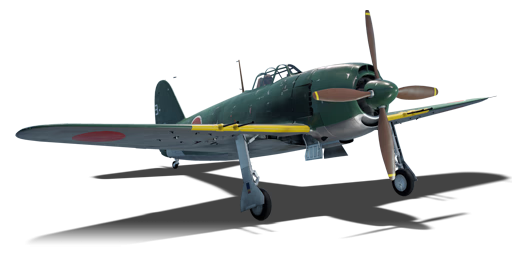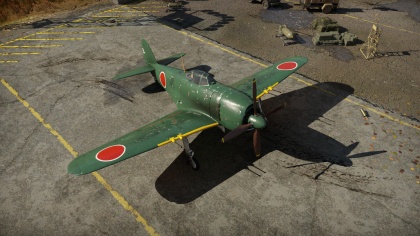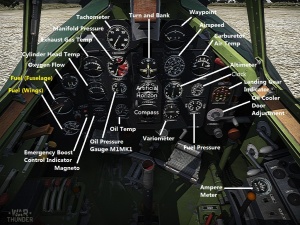Difference between revisions of "N1K2-J"
(→Pros and cons) (Tag: Visual edit) |
(→See also) |
||
| Line 256: | Line 256: | ||
== See also == | == See also == | ||
| − | ''Links to the articles on the War Thunder Wiki that you think will be useful for the reader, for example:'' | + | <!--''Links to the articles on the War Thunder Wiki that you think will be useful for the reader, for example:'' |
| − | |||
* ''reference to the series of the aircraft;'' | * ''reference to the series of the aircraft;'' | ||
| − | * ''links to approximate analogues of other nations and research trees.'' | + | * ''links to approximate analogues of other nations and research trees.''--> |
| + | ;;Related Development | ||
| + | * [[N1K1]] - (Kyofu Model 11; Base hydroplane model) | ||
| + | * [[N1K1-Ja]] - (Shiden Model 11A; N1K1-J with 7.7mm's removed from the fuselage and 4x20mm in the wings) | ||
| + | * [[N1K2-J]] - (Shiden Kai Model 21; Redesigned wings and fuselage) | ||
| + | * [[N1K2-Ja]] - (Shiden Kai Model 21A; More powerful engine, larger prop) | ||
| + | <!--;;Planes of comparable role, configuration and era--> | ||
== External links == | == External links == | ||
Revision as of 07:21, 17 November 2020
Contents
| This page is about the Japanese fighter N1K2-J. For other variants, see N1K (Family). |
Description
The N1K2-J Shiden-Kai is a rank IV Japanese fighter
with a battle rating of 5.7 (AB) and 6.0 (RB/SB). It has been in the game since the start of the Open Beta Test prior to Update 1.27.
General info
Flight performance
The N1K2-J is a versatile plane that has its great acceleration and rate of climb as the main advantage. It lacks the impressive low-speed manoeuvrability of its preceding plane in the Japanese research tree, but it can still turn against most of its fighter opposition and win the engagement. The N1K2-J's battle rating presents the potential challenge of flying against fighter jets, against which N1K pilots will have to use their high sustained rate of climb, not to be left low and vulnerable against faster enemies, as well as to use their turning ability far superior to that of the average jet.
| Characteristics | Max Speed (km/h at 6,000 m) |
Max altitude (metres) |
Turn time (seconds) |
Rate of climb (metres/second) |
Take-off run (metres) | |||
|---|---|---|---|---|---|---|---|---|
| AB | RB | AB | RB | AB | RB | |||
| Stock | 609 | 594 | 11000 | 19.4 | 20.5 | 11.7 | 14.2 | 300 |
| Upgraded | 675 | 650 | 18.5 | 19.0 | 23.2 | 18.2 | ||
Details
| Features | ||||
|---|---|---|---|---|
| Combat flaps | Take-off flaps | Landing flaps | Air brakes | Arrestor gear |
| ✓ | ✓ | ✓ | X | X |
| Limits | ||||||
|---|---|---|---|---|---|---|
| Wings (km/h) | Gear (km/h) | Flaps (km/h) | Max Static G | |||
| Combat | Take-off | Landing | + | - | ||
| 780 | 450 | 520 | 520 | 320 | ~11 | ~9 |
| Optimal velocities (km/h) | |||
|---|---|---|---|
| Ailerons | Rudder | Elevators | Radiator |
| < 430 | < 460 | < 400 | > 324 |
| Compressor (RB/SB) | ||
|---|---|---|
| Setting 1 | ||
| Optimal altitude | 100% Engine power | WEP Engine power |
| 2,000 m | 1,875 hp | 2,100 hp |
| Setting 2 | ||
| Optimal altitude | 100% Engine power | WEP Engine power |
| 5,300 m | 1,675 hp | 1,876 hp |
Survivability and armour
- 70 mm Bulletproof glass - Armoured windscreen
- 12 mm Steel plate in pilot's seat
Armaments
Offensive armament
The N1K2-J is armed with:
- 4 x 20 mm Type 99 Model 2 cannons, wing-mounted (200 + 250 rpg each wing = 900 total)
The Type 99 Model 2 cannons are very middle-of-the-road weapons that the pilot should be quite accustomed to by the time they reach the Shiden-Kai. They are not outstanding at anything but not bad at anything either, allowing it to fill most niches accordingly. However, the cannons on the Shiden-Kai are noteworthy for being armed with a ludicrous 900 rounds of ammunition, holding some of the most rounds of any cannon-armed single-engine fighter in the game, being only surpassed by Japan's own J6K1.
Suspended armament
The N1K2-J can be outfitted with the following ordnance:
- Without load
- 2 x 60 kg Navy Type 97 Number 6 bombs (120 kg total)
- 2 x 250 kg Navy Type 98 Number 25 bombs (500 kg total)
- 4 x 250 kg Navy Type 98 Number 25 bombs (1,000 kg total)
- 2 x Type 3 No.1 Mod.28 Mk.1 rockets
- 2 x Type 5 No.1 Mod.9 rockets
- 2 x Type 3 No.6 Mod.27 Mk.1 rockets
- 2 x Type 5 No.6 Mod.9 rockets
The N1K2-J can carry a number of additional loadouts under the wings. The rockets were designed for anti-air usage versus bombers, however they are quite inaccurate and only one salvo can be fired in RB/SB. Make sure to select a detonation range before spawning in. Feel free to experiment, 300-700 m are common values. The bigger 250 kg bombs are useful in long enduring games, where few players are left and victory is determined by the last ground units. Ignore the 60 kg, your cannons will do more damage in the long run.
Usage in battles
The N1K2-J is a very tricky aircraft to use. It can face early jet fighters such as the F-80A-5, Yak-15/17, He 162, J/A21R, and in Arcade, the F-84B-26. These jet aircraft hold a hefty speed advantage over the Shiden-Kai, but typically have very poor manoeuvrability, meaning the N1K pilot can abuse its excellent handling at medium speeds and shred the previously mentioned jets if their pilots are foolish enough to try and turn-fight. The one exception to this is the Yak-15, which retains the turning abilities of its airframe; the Yak-3. However, the Yak-15 suffers from a relatively low top speed and climb rate for a jet, along with sub-par vertical energy retention. Above all those, its ammunition pool is abysmal at only 120 rounds total, meaning the N1K2 pilot could potentially win an engagement just by remaining difficult to hit.
Although it can fight admirably against jets, the N1K2-J will find itself coming up short against many of the other nation's top tier superprops. It cannot keep up with the P-51H, F4U-4B, F8F, I-225, La-9, Tempests, Griffon Spitfires, G.56, late Bf 109s, or Fw 190 D's of its tier. Fortunately, most of the previously mentioned aircraft cannot turn with the N1K2, so the Shiden-Kai can use its superb mid-speed manoeuvrability to turn circles around its opponents. The main exception to this is the uncommon G.56, which is the closest thing the N1K2 has to a hard counter. It can turn with it, outspeed it, out-dive it, beat it in an energy fight and shred it with the triad of 20 mm MG 151s, so it is highly recommended to either avoid the G.56 or take it out while it's preoccupied with a teammate.
The N1K2-J can take on a relatively new role for Japanese fighters; a fighter/bomber. With its ability to mount up to 4 x 250 kg bombs or two of the massive Type 5 No.6 rockets, the N1K2 can be Japan's best ground attacker and will make enemy tanks quake in fear. The Type 98 Number 25 bombs are roughly equivalent to the American AN-M64A1 500 lb bombs, and are all mounted on wing racks, allowing for precise bomb placement on targets. On the flip-side, the Type 5 No.6 rockets have no direct comparison but play somewhat similarly to a watered-down American Tiny Tim rocket or Swedish hprak m/49 rocket. Despite their relatively low velocity and higher weight, they are still quite accurate and are able to be launched quite close to the target with minimal threat of self-damage.
Manual Engine Control
| MEC elements | ||||||
|---|---|---|---|---|---|---|
| Mixer | Pitch | Radiator | Supercharger | Turbocharger | ||
| Oil | Water | Type | ||||
| Controllable | Controllable Not auto controlled |
Controllable Not auto controlled |
Controllable Not auto controlled |
Separate | Controllable 2 gears |
Not controllable |
Modules
| Tier | Flight performance | Survivability | Weaponry | |||
|---|---|---|---|---|---|---|
| I | Fuselage repair | Radiator | 7 in (mod20) | |||
| II | Compressor | Airframe | Type 3 No.1 Mod.28 Mk.1 rockets | Type 5 No.1 Mod.9 rockets | ||
| III | Wings repair | Engine | Offensive 20 mm | 12 in (mod30) | Type 3 No.6 Mod.27 Mk.1 rockets | |
| IV | Engine injection | Cover | New 20 mm cannons | Type 5 No.6 Mod.9 rockets | ||
Top speed and acceleration is an issue with the stock aircraft, so flight performance modules such as compressor, engine and engine injection should be highly prioritized. Following the flight performance modules, survivability modules are recommended to help alleviate the weak airframe of the N1K2. Offensive 20 mm belts and new cannons should be the next acquired, as the stock Type 99 cannons are quite underwhelming and their stock belts are equally poor. Once upgraded however, the Type 99 cannons are excellent all-rounder weapons. Recommended belts are either the always good Universal, or Stealth if the pilot is familiar with the cannons and prefers a sneakier approach.
Pros and cons
Pros:
- Flight Performance
- Reasonable manoeuvrability at medium speeds (300~500 km/h)
- Great energy retention
- Solid acceleration once upgraded
- Combat flaps are efficient while in dogfighting
- Decent rate of climb
- Relatively good diving characteristics for a Japanese aircraft
- Armament
- Absurd amount of ammunition (200~250 rpg with 900 rounds in total)
- Cannons themselves are reasonable in all aspects, and take far longer to jam than their contemporaries
- Can carry as much bombs as an average Japanese army bomber
Cons:
- Flight Performance
- Mediocre roll rate
- Severely stiffens at higher speeds
- Can be outmanoeuvred easily by the fighters at its tier if not used correctly
- Unless approached correctly, completely outclassed by the Spitfire Mk. IX and F8Fs
- Stock grind can be outright painful
- Weak stock belts, which can only be unlocked at tier III
- Can catch on fire easily, and often gets destroyed in the process
- Often faces jets
History
In-game description
Kawanishi Shiden-Kai Model 21, Kawanishi N1K2-J (code name "George") Marine Interceptor-Fighter.
A single-seat, all-metal monoplane fighter with a closed canopy. The "Shiden" holds a unique place in the history of airplane construction. This land-based interceptor was based on the N1K1, which had been designed to support amphibious operations.
The first prototype N1K1 "Kyofu" ("Mighty Wind") was flown on May 6, 1942, and mass production began in May of 1943. However, when the first seaplanes started to arrive on the front, the situation in the Pacific theatre had changed so that this type of plane was simply no longer needed. Therefore, a land version project of the fighter was developed as a private initiative, based on the Kyofu. Originally it was planned that the only distinction between the two planes was that the Shiden-Kai would have retractable landing gear instead of floats, but it was quickly decided that the engine should be replaced with a more powerful alternative. A four-bladed propeller with a diameter of 3.3 meters was selected for the plane. Such a large propeller size, along with the mid-wing aerodynamic design, forced the plane to be fitted with elongated, telescoping landing gear struts which folded during retraction.
The land-based version made its first flight on December 12, 1942. The prototype's private designation was the X1, and in mass production its designation became N1K1-J "Shiden" ("Purple Lightning"). Production began in August of 1943.
The new fighter proved to be an excellent interceptor. However, its operation was complicated by the frequent failure of its engine, the Homare 21, the complex design of its chassis, and its ineffective brakes. Consequently, the number of the N1K1-J's non-combat losses was very high. The next model of the Shiden was designed to eliminate these shortcomings.
The aircraft's redesign began simultaneously with the N1K1-J's military trials. The N1K2-J's first flight was made on December 31, 1943. The production model was designated the Shiden-Kai ("Purple Lightning Improved") Model 21 Marine Fighter-Interceptor.
The new model, like its predecessor, featured a 14-cylinder air-cooled radial engine, the Nakajima Homare 21 NK9H, with a takeoff power of 1820 hp. It also retained the basic wing construction and armament of the N1K1-J. However, the Shiden-Kai was really a new plane. During the planning phase, special attention was given to ensuring ease of production and, at least to some extent, the use of readily available materials. The Shiden-Kai, unlike its predecessor, had a low-wing design which allowed the use of conventional landing gear. The new design was finally rid of the N1K1-J's main operational problems.
The shape of the fuselage was completely changed and somewhat lengthened, and the vertical tail fin was completely redesigned. The empty weight of the aircraft was decreased by 240 kilograms.
The N1K2-J was armed with 4 Type 99 Model 2 20mm wing-mounted cannons. The inner pair held 200 rounds of ammunition each and the outer held 250 each (900 rounds total).
On the two pylons suspended underneath its wings, the aircraft could carry two 250-kg type 98 or two 60-kg type 97 bombs. Or, it could carry unguided 60-kg No.27 rockets. In addition, an extra 400-litre fuel tank could be installed under the fuselage.
Because its centre of gravity was towards the plane's rear, the N1K2-J was somewhat difficult to control, and was usually flown by experienced pilots (especially former Zero pilots) after they underwent retraining.
Media
Excellent additions to the article would be video guides, screenshots from the game, and photos.
See also
- Related Development
- N1K1 - (Kyofu Model 11; Base hydroplane model)
- N1K1-Ja - (Shiden Model 11A; N1K1-J with 7.7mm's removed from the fuselage and 4x20mm in the wings)
- N1K2-J - (Shiden Kai Model 21; Redesigned wings and fuselage)
- N1K2-Ja - (Shiden Kai Model 21A; More powerful engine, larger prop)
External links
Paste links to sources and external resources, such as:
- topic on the official game forum;
- encyclopedia page on the aircraft;
- other literature.
| Kawanishi Aircraft Company (川西航空機) | |
|---|---|
| Fighters | J6K1 |
| N1K | N1K1-Ja · N1K2-J · N1K2-Ja |
| Bombers | H6K4 · H8K2 · H8K3 |
| Hydroplane | N1K1 · E7K2 |
| Japan fighters | |
|---|---|
| Navy | |
| Carrier-based fighter | |
| A5M | A5M4 · Hagiri's A5M4 |
| A6M | A6M2 mod. 11 · A6M2 · A6M3 · A6M3 mod. 22 · A6M3 mod. 22Ko · A6M5 · A6M5 Ko · A6M5 otsu · A6M5 Hei · A6M6c |
| A7He | A7He1* |
| A7M | A7M1 (NK9H) · A7M2 |
| Land-based Fighter | |
| J2M | J2M2 · J2M3 · J2M4 Kai · J2M5 · J2M5 (30 mm) |
| J6K | J6K1 |
| J7W | J7W1 |
| N1K-J | N1K1-Ja · N1K2-J · N1K2-Ja |
| Fighter seaplane | |
| N1K | N1K1 |
| A6M-N | A6M2-N |
| Army | |
| Ki-10 | Ki-10-I · Ki-10-I C · Ki-10-II · Ki-10-II C |
| Ki-27 | Ki-27 otsu · Ki-27 otsu Tachiarai |
| Ki-43 | Ki-43-I · Ki-43-II · Ki-43-III otsu |
| Ki-44 | Ki-44-I · Ki-44-I 34 · Ki-44-II otsu · Ki-44-II hei |
| Ki-61 | Ki-61-I ko · Ki-61-I otsu · Ki-61-I hei · Tada's Ki-61-I hei · Ki-61-I tei · Ki-61-II Otsu Kai |
| Ki-84 | Ki-84 ko · Ki-84 otsu · Ki-84 hei |
| Ki-87 | Ki-87 |
| Ki-94 | Ki-94-II |
| Ki-100 | Ki-100 · Ki-100-II |
| Other countries | ▅F4U-1A · ▅P-51C-11-NT · ▅Bf 109 E-7 · ▅Fw 190 A-5 |
| *Imported designation of the He 112 (A6M was in development - A7M would take A7 designation after the cancelation of the A7He) | |






